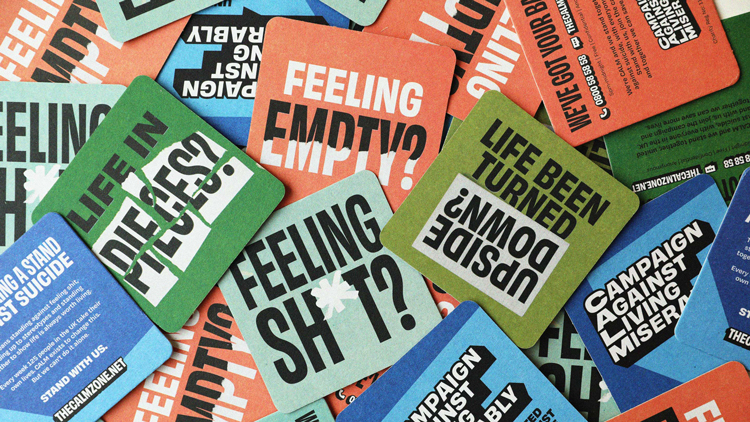Making sense of mental health: how can brands enter the conversation?

by IBRAHIM
Making sense of mental health: how can brands enter the conversation?
Reed Words writers Andrea Dunne and Gemma Wilson share tips on how copywriters and designers can help brands get to grips with the nuances of communicating mental health messages meaningfully.
Everywhere from train carriages to tissue boxes, brands are talking about mental health. But how can consumer brands find the right words to touch on this sensitive topic? One thing’s for sure, it’s not a quick fix.
Over the last 18 months, mental health has been firmly on the agenda. The language of empathy, self care, and openness has entered the public dialogue and – rightly so – it’s only getting louder.
From high street banks to sweet treats, brands are joining the conversation and amplifying an essential topic. But how should they be engaging with this knottiest of subjects, if at all?
As copywriters at Reed Words we often work with designers or directly with brands, using their voice and reach to tackle difficult topics. While we have worked with CALM ourselves, the other examples and voices here represent projects which we feel have understood various mental health challenges and communicated them well.
Stay true to your brand
When World Mental Health Day comes around, every branded Twitter account delivers a half-baked take on why you should ‘speak to someone’ about how you’re feeling. But if you don’t practice what you preach, it isn’t helping anyone and phrases like ‘time to talk’ or ‘it’s okay to not be okay’ become lost.
To avoid this trap, first make sure the brand has a reason to speak on the subject. Then, make it consistent.
Campaign Against Living Miserably (CALM) head of brand and marketing Dipika Saggi says, “Some brands start a conversation on World Mental Health day and go quiet for the other 364 days.
“People see through it — your audience knows it’s not part of your values and beliefs. By the end of it, you’ve probably done more damage to the conversation (and your brand) than good.”

Take Monzo’s approach. It promises to support customers through mental health struggles – and its employees too. This feels authentic because Monzo is taking action across its communities in a relevant way while being transparent about its motives.
Stay true to your voice
The other reason Monzo’s approach is so effective is because it’s in the same clear and simple voice they use everywhere. A brand’s voice shouldn’t shift – especially on subjects this important. It’s no good retreating into formal language any time the conversation gets sticky. Why? It undermines the message, and the discomfort is palpable. It doesn’t do a brand any good – or the audience.

Charities like CALM have honed their voice for talking to people in life’s most trying moments. And this voice is an asset for its brand partnerships too – like #ApartButTogether with Head & Shoulders. CALM’s practical, trustworthy voice brings authenticity, while Head & Shoulders expands the reach of the message.
Speak to experience
Not everyone thinks about mental health in the same way, or has the same appetite for openness. Brands entering this space need to know who they’re talking to – and talk with them, not at them.
Losing any labels is a good place to start. While brands might think to reach out to people with specific challenges, the reality is most people prefer life without labels.
Take veterans charity Combat Stress whose content and stories manager Caroline Allen says, “When veterans come to us for help, they rarely know what the matter is, they just know they don’t feel right.
“We don’t want to overwhelm or confuse them. The language we use needs to make sure they get to the right person quickly.”

Meanwhile Samaritans’ ‘We Listen’ poster campaign takes a sensitive approach, inviting the public to literally read between the lines and understand how people communicate can differ from the way they actually feel.
The ‘Every Mind Matters’ idents from the NHS and Channel 4 brings the voice of anxious thoughts to life and how they can run rampant in your mind. Without ascribing labels, they present a the reality of overwhelming anxiety.
Highlight real conversations
Experience is everything, and stories speak volumes. Especially from real people opening up about their own mental health journeys. Celebrities, influencers, even everyday people willing to share their stories.
Campaigns that lead with a human voice makes the real mental health experience visible. It’s especially powerful in underrepresented communities.
Resident Advisor’s (RA’s) partnership with Black Minds Matter focused on conversations between Black creatives working in electronic music allowing RA to support an important cause without taking over the conversation.
Keep the conversation going
Mental health is a huge topic to take on and shouldn’t be viewed as something to be solved. As it’s everchanging the single tweet approach won’t do. A successful team might think about tackling a broad range of things that people struggle to talk about or look at how to bring in a diverse range of voices as a project evolves.
Brands are slowly understanding how to engage with mental health as a subject but need to think carefully before jumping in because without the right words, platform and purpose, joining the conversation can do more harm than good. The most powerful work is from brands taking a long-term approach and partnering with organisations that can signpost to the support people need.
This helps the people who know what to say and how to say it find the people who need to hear it.
The more brands champion honesty and experience, the more they can make a difference. Conversation’s great, but when it comes to mental health – brands have to mean it.
Reed Words is a verbal branding and copywriting consultancy.
Recommended Posts

SeidrLab visual identity by Mubien Brands
October 16, 2023

NB invites local designers centre stage for Vineyard Theatre rebrand
February 24, 2023

“AI revolution” will change way design studios look within three years
February 24, 2023

